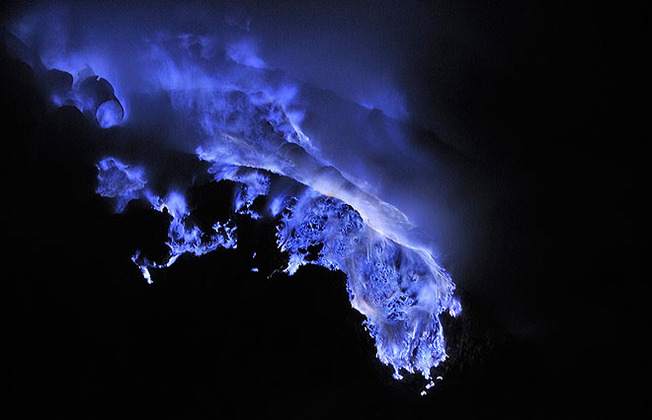An Indonesian sulfur mine by day and a spectacular - and dangerous - show by night, Kawah Ijen is the hazardous workplace of many men. Miners hike to the top of the peak, descend 660 feet into its crater, then pick up chunks of raw sulfur and slog them back up to the rim in a pair of baskets that hold 100 to 200 pounds.
The blue lava is the result of the molten sulfur just over the boiling point of water. Conditions in the crater aren’t actually hot enough for the sulfur to self-combust, so it turns molten when miners drop their torchesSulfur becomes molten at temps just over the boiling point of water and turns into the spectral blue lava you see here. Conditions in the crater aren’t actually hot enough for the sulfur to self-combust — it turns molten when miners drop their torches. .
Take a look at Olivier Grunewald's testimony about this place:
"For over 40 years, miners have been extracting sulphur from the crater of Kawah Ijen in Indonesia. To double their meagre income, the hardiest of these men work nights, by the electric blue light of the sulphuric acid exhaled by the volcano.
As the light of day recedes, an eerie incandescence appears to rise from the depths of the Kawah Ijen crater. The high-temperature liquid sulphur that flows from an active vent at the edge of the world's largest hydrochloric acid lake flares in blue flames that can reach up to 5 metres.
At the foot of the glow, miners bustle amidst the toxic fumes. They are monitoring the flow of molten sulphur as it pours out of pipes at 115 °C, and its subsequent crystallisation. Breaking up, gathering up, loading up and transporting the coagulated blood of the earth earns them a living. By the blue light of the flare, they extract hunks of sulphur, then carry them up the flank of the crater to sell for 680 roupees per kilo (about €0.04). But the loads they carry, weighing between 80 and 100 kilos, cost them their health—and sometimes their life. By working nights, they manage to haul out two loads every 24 hours, doubling their salary, avoiding the daytime heat of the Kawah Ijen cauldron, and despite the condition remaining independant.
The sulphur, among the purest in Indonesia, is destined for the food and chemical industry. Whitening sugar, at the price of their health and youth, such is the destiny of these serfs to sulphur."
The blue lava is the result of the molten sulfur just over the boiling point of water. Conditions in the crater aren’t actually hot enough for the sulfur to self-combust, so it turns molten when miners drop their torchesSulfur becomes molten at temps just over the boiling point of water and turns into the spectral blue lava you see here. Conditions in the crater aren’t actually hot enough for the sulfur to self-combust — it turns molten when miners drop their torches. .
Take a look at Olivier Grunewald's testimony about this place:
"For over 40 years, miners have been extracting sulphur from the crater of Kawah Ijen in Indonesia. To double their meagre income, the hardiest of these men work nights, by the electric blue light of the sulphuric acid exhaled by the volcano.
As the light of day recedes, an eerie incandescence appears to rise from the depths of the Kawah Ijen crater. The high-temperature liquid sulphur that flows from an active vent at the edge of the world's largest hydrochloric acid lake flares in blue flames that can reach up to 5 metres.
At the foot of the glow, miners bustle amidst the toxic fumes. They are monitoring the flow of molten sulphur as it pours out of pipes at 115 °C, and its subsequent crystallisation. Breaking up, gathering up, loading up and transporting the coagulated blood of the earth earns them a living. By the blue light of the flare, they extract hunks of sulphur, then carry them up the flank of the crater to sell for 680 roupees per kilo (about €0.04). But the loads they carry, weighing between 80 and 100 kilos, cost them their health—and sometimes their life. By working nights, they manage to haul out two loads every 24 hours, doubling their salary, avoiding the daytime heat of the Kawah Ijen cauldron, and despite the condition remaining independant.
The sulphur, among the purest in Indonesia, is destined for the food and chemical industry. Whitening sugar, at the price of their health and youth, such is the destiny of these serfs to sulphur."
~Ally

 RSS Feed
RSS Feed